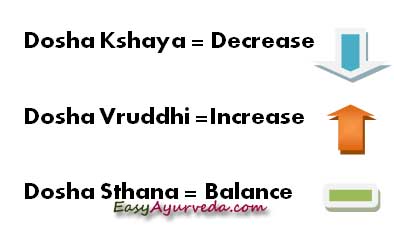Decrease, Balance And Increase Of Doshas – Kshaya, Sthana, Vruddhi
Article by Dr Raghuram Y.S. MD (Ay) & Dr Manasa, B.A.M.S
Table of Contents
Introduction
Dosha Kshaya means decrease of doshas
Dosha Samya means normalcy, balance or equilibrium of doshas
Vriddhi means increase of doshas.
Kshaya, Sthana and Vriddhi are considered to be one triplet among different forms of dosha movements.
Increase or decrease of Dosha leads to diseases.
Related Reading – Dosha Dushti according to Dosha Gati
Though equilibrium is a normal state of doshas and do not produce any dosha vitiation or disease, it is included in the triad to make it convenient to understand. The pathological states of increase and decrease of doshas shall be understood only with the knowledge of and in relation to the sthana or saamya of doshas.
Doshas are the body components in the form of energy (shaktirupa dravyas) of the body. They are responsible for all the normal activities of the body and maintenance of health when they are in a state of balance.

Dosha Kshaya
Dosha Kshaya or decrease in Dosha
Dosha decrease can be qualitative or quantitative. The decreased doshas do not cause any disease or disturbance. But they exhibit symptoms of their decrease.
The decreased dosha will not be functionally active or it would not be capable enough of rendering its normal functions to its fullest capacity.
Read related: Vata Kshaya Lakshana: Symptoms Of Decrease Of Vata Dosha
When there is decrease of one Dosha, there may be simultaneous increase of another dosha which has qualities opposite to that of the decreased Dosha. The other dosha may be disturbed in the package or may remain in a normal state.|
Example, when there is kapha (oiliness) is decreased, there may be a simultaneous vata vriddhi (dryness).
Read related: Pitta Kshaya Lakshana – Signs And Symptoms Of Pitta Decrease
Decrease may not need many interventions. The dosha kshaya may rectify by itself, sometimes by corrections in diet and lifestyle and sometimes due to change in season or when the other dosha which has undergone increase is treated effectively.
If the functions of a particular dosha are too deficit due to kshaya, food and activities similar to the qualities of the ksheena dosha shall be given.
Read related: Kapha Decrease Symptoms, Analysis, Treatment
But doshas constantly left at a state of inadequacy is also not good for the soft functioning of the body. The decreased doshas shall be increased with effective medicines and brought back to normalcy.
Does decrease of Dosha lead to diseases?
At the most, Ksheena Doshas (decreased) can produce their own symptoms but cannot go on further to vitiate tissues to cause a full-fledged disease. Charaka Sutrasthana 17/62
Chakrapani
स्वमानक्षीणा दोषा किंचिद्विकारं न जनयन्ति, क्षीणलक्षणं वैषम्यमेव परं यान्ति वचनं हि क्षीणा जहति लिंगं स्वं समा:स्वं कर्म कुर्वते
Decreased Doshas cannot vitiate other Doshas – Charaka Vimana 5/23.
क्षीणाश्च दोषा नान्यदुष्टिं कुर्वन्ति , किन्तु स्वयमेव क्षीणस्वलिंगा भवन्तियादि वेदितव्यम्।
Nearing to death, all factors are ksheena – agni, Praana, Ojas, Tejas, Bala, Dhatus and also the Doshas.
Dosha Sthana
Dosha Sthana (Dosha Saamya) or normal and balanced state of dosha
As already said, the doshas when in a state of balance, they would participate in all the activities of the body and help in smooth running of the body mechanics and dynamics. They essentially contributes to good and balanced health.
When in a state of normalcy, the doshas do not cause any disease or disturbance. They just perform their normal functions.
It is very essential to maintain this balance of the doshas always. Efforts should be put to keep these doshas in a state of balance by taking good foods and following a disciplined lifestyle, by following the regimen of day, night and seasons properly, keeping away from bad habits, bad company and leading a good social life with ethical way of living.
Dosha Vriddhi
Dosha Vriddhi – increase
Among the triad of kshaya-sthana-vriddhi, it is the increase in dosha which has pathological importance. It is this state of dosha which needs a monitor as long as the manifestation of disease is concerned.
Read related: How To Observe Pitta Dosha Imbalance
Dosha increase can also be qualitative or quantitative or functional. Since dosha vriddhi is involved with hyperactivity and damaging effect, it would need timely attention and proper interventions.
Read related: How To Observe Vata Dosha Imbalance Symptoms?
Increased Doshas exhibit symptoms called Dosha vriddhi lakshanas. Qualities and functions of the increased Dosha will be exaggerated which may ultimately lead to damage of tissues (dhatus) and channels leading to manifestation of diseases. When not taken care of them, the increased doshas may progress into the other pathological states and cause diseases.
Read related: How To Observe Kapha Dosha Imbalance Symptoms In Your Body By Yourself?
Do the increased doshas always cause diseases?
Well, the increased doshas do not always cause diseases. They may cause some degree of disturbance but not produce diseases essentially.
After consumption of nidanas or causative factors, the doshas initially undergo increase and accumulate in their chief sites (sanchaya). When this state is not taken care of, the doshas gradually increase to higher levels and get aggravated, still in their own sites (prakopa). This sanchaya and prakopa of doshas take place normally too as an impact of season (apart from their increase due to nidanas). This is called prakrita dosha dushti.
Related Reading – Seasonal changes of Doshas
Prakrita dosha dushti can also take place due to changes in diurnal changes and during different phases of food.
When rutucharya or seasonal regimen is followed properly, the doshas get settled down in the upcoming season or when etiological factors are kept away (avoided). This auto-pacification of doshas is called shamana.
When seasonal regimen is not followed properly or when etiological factors are consumed even in prakopa stage or when prakopa of doshas is not timely attended with suitable interventions, the doshas proceed through other stages of pathogenesis i.e. kriya kala and cause diseases.
Related Reading – Kriya Kala – stage wise manifestation of diseases
The doshas undergoing increase can be prevented from going through pathological stages leading to manifestation of diseases through early diagnosis and prompt intervention of earlier stages.
Treatment of increased doshas should be carried out in an intensive way. Shodhana or expulsion of doshas through Panchakarma (five cleansing treatments) measures forms the key strategy of dealing with vriddhi doshas. If the doshas are constantly increasing, the shodhana too should be frequently done.
Shamana aushadhas (palliative or pacificatory medicines),
pathya ahara (balanced and nutritious diet), healthy lifestyle and consumption of medicines to prevent recurrence of diseases and to enhance immunity (rasayanas) should be consumed in the follow up so as to avoid frequent vriddhi of doshas and keep up the health.
Importance of Kshaya, Sthana, Vriddhi
Importance of the knowledge of Kshaya, Sthana and Vriddhi of Doshas
The knowledge of normalcy and pathological increase or decrease of doshas will help the physician to discriminate between the normal and abnormal (pathological) states of doshas. This is very important from the treatment perspective. The ksheena doshas shall be increased and brought back to normalcy. The vriddha doshas shall be decreased and brought back to normalcy. The normal doshas should just be maintained at the normal levels by following a proper lifestyle and diet protocol.
Read related: Normal Dosha Vitiation In Relation To Digestion
Just Before Finishing –
In this article we have discussed in detail about the kshaya sthana and vriddhi of doshas and the methods of dealing with these conditions. Comprehensive knowledge of these stages of doshas or dosha gatis is very much essential for a physician so that he can identify these stages properly and deal with pathological states of doshas (kshaya and vriddhi) while keeping the normal doshas in balance.
Click to Consult Dr Raghuram Y.S. MD (Ayu) – Email / Skype








